Over the past decade, both the demand and the price of gold have been on an increasing trend across the world. This belief in gold as a safe haven increased post the global financial meltdown in 2008. The yellow metal has been considered as a safe asset having stable value that is immune to inflation. People have been hoarding this asset despite it not paying interest like a fixed income investment or dividends like equity shares.
However, the past one week has witnessed a free fall in the price of gold, falling close to 12 per cent in one week. Improving economy in the US leading to the belief that gold need not be held as a hedge, as well as profit booking has led to the gradual correction in gold prices internationally. What specifically triggered off last week’s fall were reports that some central banks, such as Cyprus, were selling gold. It was expected that some European countries will also start selling their gold reserves. Experts consider this fall to be the largest decline in gold prices in the last 30 years.
Let’s consider how this recent fall in prices has affected two sections of retail consumers in India: individuals buying gold for consumption purposes and individuals buying gold for investment purposes.
Although the fall in gold prices may not spell good news for everyone, individuals who purchase gold for consumption purposes are delighted by falling prices. The plunge has prompted a rush in physical gold purchases across India, and across all sections of the society. This is not surprising, as Indians are known for their affinity towards the yellow metal. In India, gold purchases are influenced by non-traditional factors like festivals, wedding seasons, harvest turnouts, etc., unlike in other countries. India is the largest consumer of gold in the world with an annual consumption of 963 tonnes (in 2010) and accounts for 31.5 per cent of the world gold consumption. Of the total demand, around 77 per cent is in the form of jewellery.
Understandably, the fall in prices has led to a spurt in jewellery purchases. Although current prices are still higher than what they were a few years back, the average Indian consumer views this fall as an opportunity to augment more of the yellow metal. Jewellery shop owners are also expecting this trend to continue, after two years of lacklustre purchases. With the wedding season coming up, jewellers are making every use of this chance to increase sales. Some jewellers have also said that the Akshaya Tritya festival, which falls in May, will help in boosting sales, as this is considered to be an auspicious time to purchase gold.
A majority of Indians have traditionally preferred buying gold jewellery instead of investing in other forms of gold investments. This trend has slowly changed in the country, especially among the investment-savvy class. This brings us to the next class of retail individuals, who purchase gold for investment purposes.
One common investment vehicle for gold, which has increased popularity in the recent past, is the gold exchange traded fund (ETF).
Gold ETFs are exchange traded units by mutual funds, which track the performance of gold, and are traded on the exchange like a stock. Mutual funds in India have been pushing gold ETFs in the past few years and the assets under management (AUM) was also rising due to the rising price of gold. However, ETFs have seen increased redemption in the last fiscal year, compared to the period 2007-2011. The recent fall in prices has led many to believe that funds can face increased redemption pressures if this trend continues. This is because of the general change in belief that gold is a safe haven, and also due to profit booking after gold reached all-time highs.
Nevertheless, despite the recent fall in prices, experts believe that gold has not lost its sheen, and is a good long-term asset. The increase in physical gold purchases signifies that the common man still holds this asset in great value. Although prices are expected to correct further in the short term, gold is expected to give healthy returns over a long term horizon, and as a result one should accumulate more gold ETFs as the price falls. Gold is a good hedge and should be held to some extent in every person’s investment portfolio from the point of view of diversification, especially in times of uncertainty.

.jpg)








